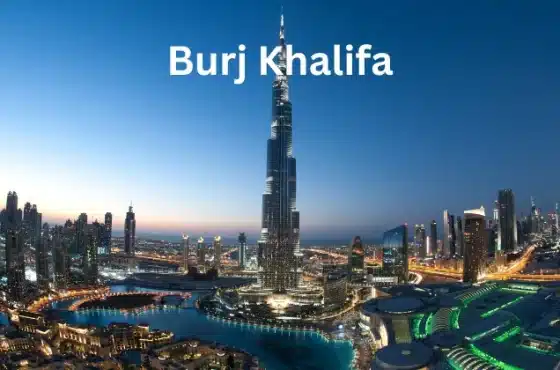At the top of the Burj Khalifa Tower in Dubai, there are observation decks known as “At the Top” and “At the Top Sky”. These observation decks offer breathtaking panoramic views of Dubai and beyond. “At the Top” is located on the 124th and 125th floors, while “At the Top Sky” is on the 148th floor, making it one of the highest observation decks in the world. Visitors can experience stunning views of the city, the coastline, and the desert from these vantage points, making it a popular attraction for tourists and locals alike.
Learn more about the top of the Burj Khalifa Tower
Dubai’s Towering Achievement
In the heart of Dubai stands a testament to human ambition and engineering prowess—the iconic Burj Khalifa. This towering marvel not only dominates the city’s skyline but also serves as a symbol of Dubai’s rapid development and global prominence. In this article, we’ll take a closer look at this, exploring its design, construction, and cultural significance.
The Vision Behind Burj Khalifa
The Burj Khalifa, originally known as the Burj Dubai, was conceptualized as part of Dubai’s ambitious plans for urban development and economic diversification. Designed by the renowned architect Adrian Smith, the project was commissioned by Sheikh Mohammed bin Rashid Al Maktoum, the ruler of Dubai, to create an iconic structure that would showcase the city’s modernity and ambition on the world stage.
A Fusion of Innovation and Elegance
Height and Structure
Standing at a staggering height of 828 meters (2,717 feet), the Burj Khalifa holds the title of the tallest building in the world. Its sleek, tapering design was inspired by traditional Islamic architecture, with the tower’s spiraling minaret-like structure symbolizing growth and prosperity.
Facade and Materials
The exterior of the Burj Khalifa is clad in reflective glazing and aluminum panels, giving it a shimmering appearance that changes with the light. The use of high-quality materials, including reinforced concrete and steel, ensures the tower’s stability and durability in the face of Dubai’s extreme climate conditions.
Interior Spaces
Beyond its impressive exterior, the Burj Khalifa houses a diverse range of residential, commercial, and hospitality spaces. From luxurious apartments and corporate offices to world-class restaurants and observation decks, the tower offers a unique blend of lifestyle amenities and panoramic views of the city below.
Overcoming Engineering Challenges
The construction of the Burj Khalifa was a monumental undertaking that required innovative engineering solutions and meticulous planning. One of the key challenges faced by the project team was the foundation design, as the tower had to be supported on a relatively small footprint of land.
To address this issue, engineers employed a groundbreaking “piled raft” foundation system, consisting of a network of reinforced concrete piles and a massive concrete raft slab. This innovative approach allowed the weight of the tower to be evenly distributed across a larger area, ensuring its stability and structural integrity.
In addition to the foundation, the construction process also involved several other engineering feats, including the use of high-strength concrete and advanced wind engineering techniques to mitigate the effects of Dubai’s strong winds on the tower’s stability.
Beyond Architecture
Global Landmark
Since its completion in 2010, the Burj Khalifa has become synonymous with Dubai’s rise as a global hub for business, tourism, and innovation. Its distinctive silhouette has graced countless postcards, travel brochures, and media outlets, drawing visitors from around the world to marvel at its beauty and grandeur.
Economic Impact
The presence of the Burj Khalifa has had a significant economic impact on Dubai, driving investment, tourism, and job creation in the region. Its status as a premier destination for luxury living and entertainment has attracted high-net-worth individuals and multinational corporations, further enhancing Dubai’s reputation as a cosmopolitan metropolis.
Cultural Legacy
Beyond its economic and architectural significance, the Burj Khalifa holds a special place in the hearts of the Emirati people, symbolizing their pride, resilience, and vision for the future. It serves as a reminder of Dubai’s transformation from a humble fishing village to a modern-day marvel of innovation and progress.
Exploring Beyond
For those interested in experiencing the grandeur of the Burj Khalifa firsthand, guided tours are available for visitors to explore its observation decks, sky lounges, and interactive exhibits. Click here to learn more about ticket prices, tour packages, and special events at the world’s tallest building.
Conclusion: A Sky-High Inspiration
In conclusion, the Burj Khalifa stands as a shining example of human ingenuity and aspiration, pushing the boundaries of what is possible in the realm of architecture and engineering. From its groundbreaking design to its cultural significance, this towering marvel continues to captivate and inspire people around the globe, reminding us of the power of vision, perseverance, and innovation. As Dubai’s most iconic landmark, it serves as a beacon of hope and progress for generations to come.
Hotels near Burj Khalifa Dubai:
If you’re looking for hotels near the Burj Khalifa Tower in Dubai, there are several options available that cater to different preferences and budgets. Here are a few notable ones:
- Address Downtown: This luxury hotel is located directly adjacent to the tower and offers stunning views of the iconic tower. It’s known for its elegant accommodations and excellent service.
- Armani Hotel Dubai: Situated within the tower itself, this exclusive hotel is designed by Giorgio Armani and offers luxurious rooms and suites with unparalleled views of the city.
- The Palace Downtown Dubai: Located near the tower and overlooking the Dubai Fountain, this hotel combines traditional Middle Eastern architecture with modern luxury.
- Rove Downtown Dubai: A more affordable option, Rove Downtown Dubai is just a short walk away from the Burj Khalifa and offers comfortable accommodations with a trendy vibe.
- Vida Downtown: Another stylish option nearby, Vida Downtown offers contemporary rooms and is within walking distance to the Burj Khalifa and Dubai Mall.
These hotels offer a range of amenities and proximity to the Burj Khalifa, ensuring you have a convenient and enjoyable stay in Dubai.
FAQs
- How tall is the Burj Khalifa?
- The Burj Khalifa stands at a height of 828 meters (2,717 feet), making it the tallest building in the world.
- How long did it take to build the Burj Khalifa?
- Construction of the Burj Khalifa began in 2004 and was completed in 2010, taking approximately six years to finish.
- Can visitors go to the top of the Burj Khalifa?
- Yes, visitors can access the observation decks located on the 124th and 148th floors of the Burj Khalifa for panoramic views of Dubai’s skyline.
- How many floors in Burj Khalifa?
- The Burj Khalifa has a total of 163 floors above ground. The Burj Khalifa floors serve various purposes including residential apartments, corporate offices, restaurants, observation decks, and other facilities. The building also has several mechanical floors and a spire at the top. It stands as the tallest building in the world.
Find restaurants near tourist places here





